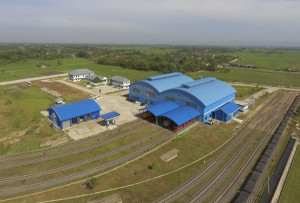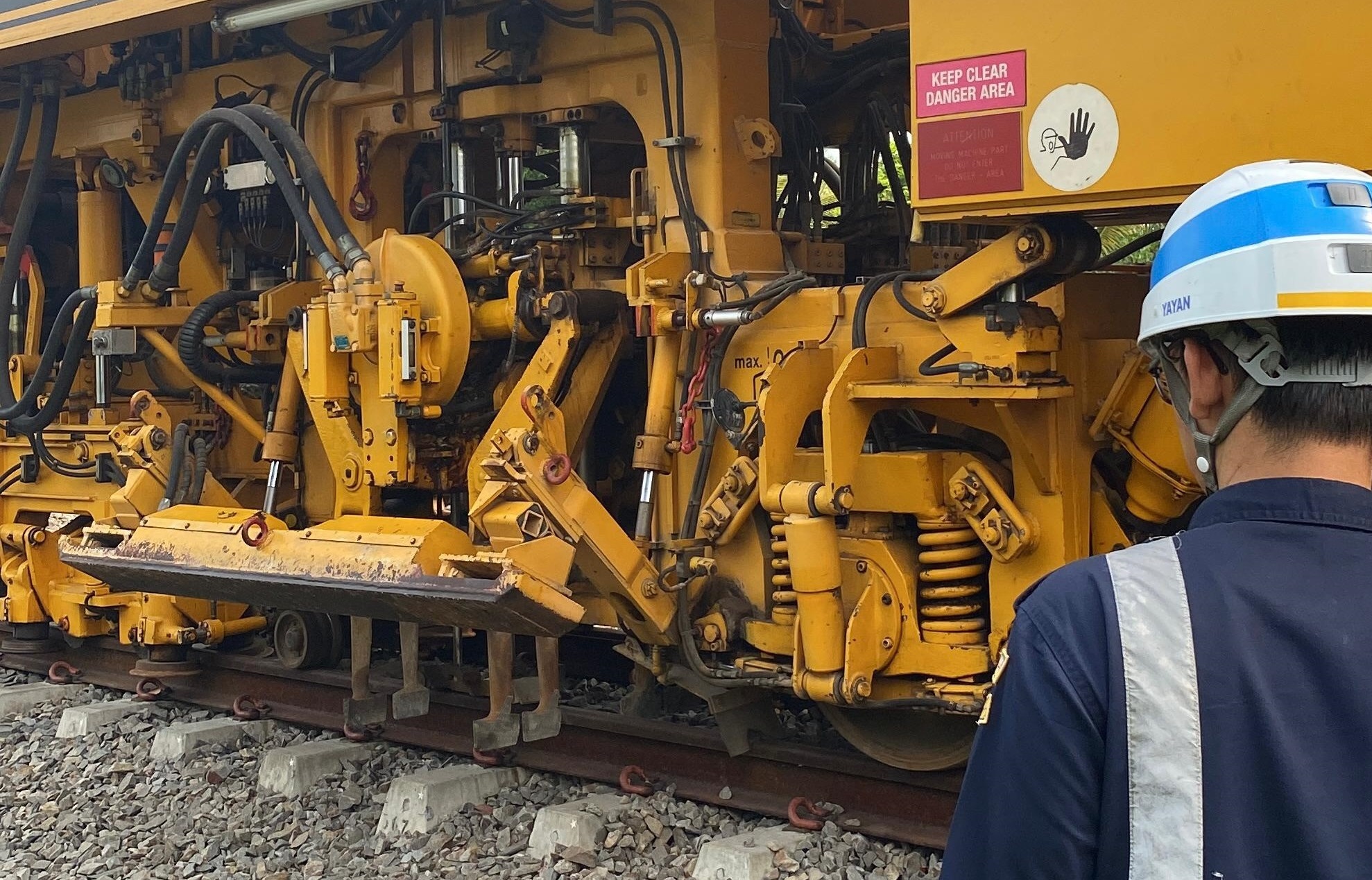Introducing (Again).. We are the Balai Perawatan Perkeretaapian

Balai Perawatan Perkeretaapian (The Railway Maintenance Center) is part of the Ministry of Transportation of the Republic of Indonesia, with a vertical line of command under the Directorate General of Railways.
The Railway Maintenance Center is a Technical Service Unit (UPT) under the Ministry of Transportation, especially the directorate general of railways. The interesting thing about the Railway Care Center is that this UPT has a special mandate that no other UPT has. The Railway Maintenance Center is tasked with carrying out maintenance in the field of railways, equipped with various facilities and equipment to support adequate maintenance.
The regulatory center was formed in 2014, but operationally the maintenance task will continue in 2019 with the existence of a workshop building, which will then be equipped with maintenance facilities for the Ngrombo Workshop and effectively connected to railroad traffic at the end of 2020 which will then be at the beginning of 2021 locomotive railway facilities, trains and carriages began to arrive into the Ngrombo Workshop emplacement at the Railway Maintenance Center.
For information, before 2014 or before the Railway Maintenance Center was formed, the government had a number of special railroad facilities and facilities whose management was carried out by the Directorate General of Railways (DJKA). The procurement and maintenance costs come from the State Revenue and Expenditure Budget (APBN).
The maintenance of several special government-owned railway facilities and equipment was initially included in the maintenance facility owned by PT Kereta Api Indonesia (Persero). PT KAI (Persero)'s maintenance facilities are still called depots and facilities yasa centers.
With this situation, in terms of governance, the Directorate General of Railways cannot implement it optimally. In its implementation, it is carried out under the Maintenance Service Agreement (MSA) pattern and is carried out by the railway operator, whose fees are then billed to DJKA.
Therefore, the Railway Maintenance Center was formed to meet the needs of the government's railway maintenance center, so that it can be managed properly and effectively.
The government's Railway Maintenance Center is expected to be able to carry out its duties effectively and efficiently, both in terms of organization, work patterns, quality and financing.
In order to realize this task, the Railway Maintenance Center has a vision, namely the realization of reliable, professional facility maintenance, prioritizing quality and independence and mission, firstly to realize the readiness and reliability of railway facilities; and secondly increasing the role of organizational management in the successful implementation of tasks and functions.
This vision is related to the security and safety improvement strategy included in the 2011 National Railway Master Plan (RIPNAS) document. This aspect is the main indicator of the success of transportation service delivery because it relates to safety.
Strategic steps are needed to minimize the incidence of accidents through safety improvement programs (road map to zero accidents). The hope is that in 2010-2030 there will be an increase in railway security and safety.
The main programs compiled to realize these strategic steps include preparing safety and security regulations in accordance with developments in railway technology at the regulatory level, developing a "Safety Management System" in managing railways.
Railway Maintenance Agency Regulations
In relation to improving rail transportation safety, the Directorate General of Railways (DJKA) has created a railway sector management organization in accordance with the mandate of Law Number 23 of 2007 concerning Railways.
These organizations include the UPT Railway Center, the UPT Testing Railway Infrastructure and Facilities and also the UPT Maintenance of Railway Infrastructure and Facilities.
It is the UPT for the Maintenance of Railway Infrastructure and Facilities that is currently known as the Railway Maintenance Center.
Article 18 and Article 25 of Law Number 23 of 2007 clearly state that there is a maintenance mandate, one of which is carried out by the Railway Maintenance Office. Article 18 reads that the implementation of public railways includes one of them in letter c) is maintenance of infrastructure. Article 25 reads that the management of public railway facilities includes activities, one of which is referred to in letter c) is the maintenance of facilities (railway).
Article 25 letter c) is also emphasized in Article 29 which is mandatory for, firstly, meeting the maintenance standards of railway facilities; and secondly, carried out by personnel who meet the requirements and qualifications of expertise in the field of railway facilities.
This maintenance task is then emphasized in detail in Government Regulation Number 56 of 2009 concerning Railway Operations. In article 229 there are two paragraphs, which contain the obligation of the operator of the railway facilities to carry out maintenance on the railway facilities so that they remain operational, and the maintenance is carried out according to a set schedule.
The policy of the Railway Maintenance Center is contained in the Regulation of the Minister of Transportation of the Republic of Indonesia Number PM 65 of 2014 concerning the Organization and Work Procedure of the Railway Maintenance Office.
Article 3 of the Ministerial Regulation contains the duties of the Railway Maintenance Agency to carry out its functions, firstly, carrying out periodic maintenance of state-owned railway facilities, secondly, carrying out heavy maintenance for state-owned railway facilities, thirdly, implementing quality control of state-owned railway facilities' maintenance, and fourthly, implementing affairs management. administration, household, staffing, finance, legal, logistics, and public relations.
Management of Railway Maintenance with K3 Insight
Through the series of formation processes above, the operational area of the Railway Maintenance Center has a lot to do with the implementation of maintenance activities through the work of inspecting the components of the railway facilities and infrastructure equipment.
While the treatment itself in the Journal of Land Transportation Research Vol 17 No. 2 in the journal entitled Evaluation of the Maintenance of Railway Facilities at PT Kereta Api Indonesia (Persero) is defined as activities directed at a goal to ensure the functional continuity of a production system or equipment so that results can be obtained in accordance with the desired. Implementation of maintenance is considered successful if the system can perform its functions according to plan and does not experience damage during the system is functioning or before the planned period.
The maintenance facility for the Railway Maintenance Center is in the Ngrombo Workshop which is located in Grobogan Regency, Central Java Province, to be precise in Depok Village, Toroh District. Approximately 45 km from the north of Solo City, and about 48 km from the southeast of Semarang City.
The Ngrombo Workshop stands on an area of 6.4 hectares and has a building area of 3,888 square meters. It has eight railroad tracks. Four rail lines open inside the workshop building, four other lines extend to the east side of the workshop building.
There are four lanes inside the workshop building, two of which are underfloor spoor facilities, and the other two have underfloor spoor facilities. Both types of spoors are useful when carrying out maintenance activities on the basic parts of the railway facilities, such as wheels, bogies or braking systems.
If the four spoor lines can access the facilities inside the workshop building, then the four spoor lines that are outside the room can be used for the stabling of the railway facilities, during the maintenance or storage process.
In addition to having a workshop building, the Railway Maintenance Center is also equipped with a warehouse building for special equipment for railway facilities, for storage of maintenance facilities and facilities inside. Then a special oil refueling station, then the head office building with mosque facilities, and also a two-story mess building.
These buildings and buildings are equipped with Occupational Safety and Health (K3) installations, including division of work areas by floor color, as well as Personal Protective Equipment (PPE) and Light Fire Extinguishing Equipment (APAR) facilities that are available in open areas and easy to reach.
This is also part of the activity stage for the development of the Railway Safety Management System (SMKP), as well as the active participation of the Railway Maintenance Office in implementing safety management in the work environment.
The railway regulator, in this case, is the government as the regulator which provides guidelines, instructions and laws and regulations concerning the implementation of the operation of the railway, it is necessary to have standards for safety management.
Safety management is needed to be able to support the safe operation of trains. To be able to achieve this, a safety management tool is needed that involves all elements.
The Railway Care Center implements SMKP as the implementation of maintenance management with an occupational safety and health perspective, with the aim of, firstly, improving planned, structured, measurable and integrated railway safety, secondly preventing incidents and/or train accidents and thirdly creating a place and HR work environment safe, secure, comfortable, and efficient railways. (yogo)



.jpg)

Komentar
LOGIN FOR COMMENT Sign in with Google